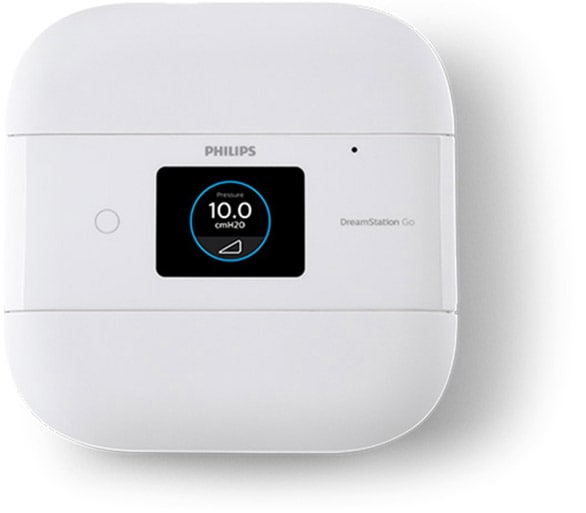Pack performance everywhere you go
At Philips, we know that wherever you go, sleep apnea follows – and we understand that a sound, restful sleep is something you can’t do without. That’s why DreamStationGo Travel PAP machine is an indispensable travel partner – at less than two pounds.

Trusted technology with the same high performance as your DreamStation home machine Portable power with optional integrated overnight battery, for the freedom to sleep off the grid Easy to use intuitive color touch screen for quick, simple setup and navigation Packability that easily stows in existing baggage with a slim profile and micro-flexible tubing
How to choose a travel CPAP
Travel CPAP machines aren’t all created equal
New innovations in design and technology have made it possible to experience the same performance with a travel PAP device as a home-based unit. But remember: Not all travel machines are the same. Tips! Here’s what to look for when deciding on a travel PAP:

A quiet operation
Check the sound level, since some machines are noisier than others.

Similar settings
Look for comfort features similar to your home device.

Portability
Opt for a lightweight machine with smaller tubes for easier packing and transporting.

Travel-friendly features
Consider touch screen activation and a built-in USB charging port for your cell phone or other devices.
Travel tips

Talk to your travel carrier in advance Call your carrier to find out what you’re allowed to bring. If required, your doctor can provide a letter of medical necessity for your equipment.

Always carry your prescription Ask your doctor for a copy of your prescriptions for your PAP machine, mask, filters, tubing and humidifier – and keep them handy.

Determine the power supply type at your destination PAPs power on with most voltages from around the world. To travel light, bring a universal power adapter.

Pack an extension cord Keep an extension cord in your PAP carrying case to make powering your therapy easier.

Bring a back-up power supply Power outages can happen any time, and you may not have access to an electrical outlet. It’s smart to pack a portable battery.

Keep sleep a nightly priority Travel can disrupt your sleep schedule. Still, aim for eight hours of sleep every night and never settle for less than six.
Flying with CPAP

To keep your machine clean, purchase a travel case or place it in a large, clear plastic bag before placing it in the bin.

You can request that the TSA agent wear new gloves, clean the table and use a new explosive trace device sampler before handling your machine.

Be sure to place the machine securely in a travel case made for your equipment or a padded carry-on suitcase. Travel PAPs are now available that fit easily into a carry-on.

If you’re questioned, show the bottom of your machine, which states that it is “medical equipment” and “suitable for airline use.”
Frequently asked questions
- How does PAP or CPAP therapy work?
-
CPAP (Continuous Positive Airway Pressure) provides a gentle flow of positive-pressure air through a facial mask to keep the airway open during sleep. As a result:
- Breathing becomes regular during sleep
- Snoring stops
- Restful sleep is restored
- Quality of life is improved
- Risk for high blood pressure, heart disease, heart attack, stroke and motor vehicle and work accidents is reduced
- What are the benefits of regular usage of PAP therapy?
-
Most PAP users who remain committed to treatment enjoy:
- Increased energy and attentiveness
- Fewer morning headaches
- Reduced irritability
- Improved memory
- Increased ability to exercise
- Lower blood pressure
- Decreased risk of strokes and heart attacks
- Increased effectiveness at home and at work
- Improved overall quality of life
- What does a mask do?
-
Masks are used to deliver the air from the therapy device to you. A comfortable mask is a key factor in being able to use your treatment daily, so finding a mask that fits you and your lifestyle is important. Most masks have built-in exhalation ports that vent your exhaled air. Talk to your homecare provider about the different masks and headgear available.
- What does tubing do?
-
The tubing is used to carry the air from the therapy device to the mask. You should clean and inspect your tubing at least once a week to make sure it is clean, bendable and that is doesn’t have any tears. If you think your tubing is ready for replacement, contact your homecare provider.
- What do filters do?
-
Therapy devices come with filters. Some devices come with one regular filter and others come with two—one regular filter and one ultra-fine filter. See your device manual for details on caring for your filters.
- Can I take my CPAP machine through airport security?
-
CPAP and BiPAP machines are allowed through TSA security checkpoints once they have been screened. You will need to remove the device from its carrying case. Mask and tubing may remain in the carrying case. If your device can be used on the aircraft, the bottom of your device will have a note stating that it is medical equipment and will have a picture of an airplane with a circle around it. If your device does not have this picture, you will not be allowed to use it on-board the aircraft.
Please note that your machine does not count as your carry on. It is not recommended that you that you check your device through checked baggage because the carrying case is not designed to protect it. It is always recommended that you bring a copy of your prescription with you in case there are questions.

Have a question?
We’re here to help
Phone: 0800 1300 844 Hours: Monday-Friday, 9am – 5pm GMT
Email our sleep apnea care team at src.support.uk@philips.com

Looking for more information?


